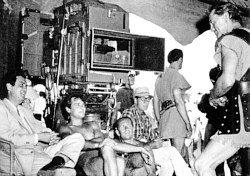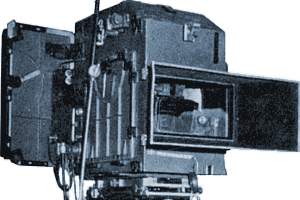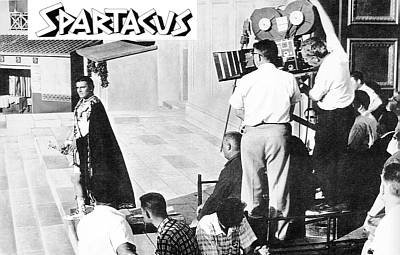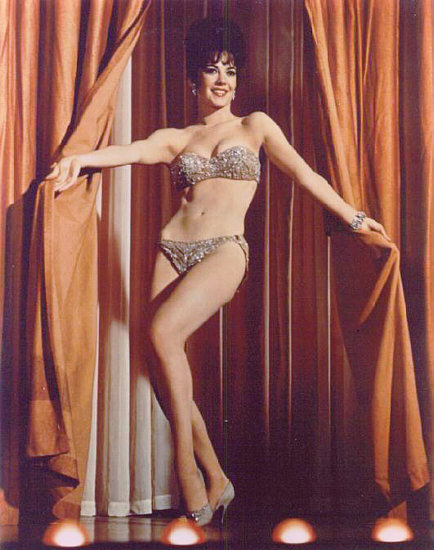


Above left, Technirama photographing Jean Simmons
in the final scene of Spartacus (1960). The
Director of Photography was Russell Metty, ASC. Above right, director Stanley
Kubrick coaching Tony Curtis on how to say, "I love you, Spartacus."
Spartacus from
8-perf negative to 35mm and 70mm

With the advent of 70mm printing, the Technirama negative image area
was increased vertically making it virtually identical in dimensions to
VistaVision. The Delrama anamorphic adapter imparts a 1.5:1 squeeze.
This produces an image with an overall 2.25:1 aspect ratio. From this negative,
a 2.35:1 aspect ratio 35mm CinemaScope compatible anamorphic print is produced
by adding an additional 1.33:1 squeeze in the laboratory and reduction
printing with a 90 degree rotation.

A 35mm 2:1 squeeze CinemaScope compatible anamorphic frame is illustrated.
The sound can be magoptical using the smaller CinemaScope perforations,
(shown here), or standard optical track. Printer optics for 35mm films
were manufactured by Taylor, Taylor, and Hobson of the United Kingdom
The 8-perf horizontal print concept for use
in large theatres saw minimal European useage because the standard CinemaScope
compatible anamorphic prints proved to have outstanding screen quality
and 70mm printing, developed under the sponsorship of Walt Disney and with
the help of Panavision, Inc. made for a TODD-AO compatible format. Films
destined for 70mm release were labeled as being made in Super Technirama
70, even though the actual photography was standard Technirama. Due to
the prestige of 70mm productions, a great many films that were never destined
for large format prints were labeled as being in Super Technirama. On the
other hand, several films that were run in roadshow in Super Technirama
70 were advertised as being in Technirama for their 35mm general release.

The same frame as printed up to 70mm. The printer lenses were manufactured
by Panavision, Inc. This film sample is from a work print which has not
had the four magnetic sound stripes added.
Film courtesy of
Robert A. Harris, The Film Preserve Ltd.


We provide these two pictures to clarify the somewhat confusing photographic credits, both on-screen and in print ads, stating that Spartacus used photographic lenses by Panavision. Seen in the front of the camera is the distinctive Delrama anamorphic optic which was used with prime lenses by Taylor, Taylor & Hobson. Panavision's credit refers to printer lenses used to convert the 8-perf 35mm negative to a 70mm 5-perf print. Spartacus had been slated to be the first live action picture to utilize the Super Technirama 70 format, but its extended production time allowed the system to be used on Solomon and Sheba first. Publicity departments being what they are, a reissue of the film made no mention of Technirama or Super Technirama 70, instead the new ad materials said it was in Panavision and Technicolor. Incorrect for sure, but it was in indication of the wide acceptance of Panavision technology.
 |
|
ABOVE: Publicity photo of Spartacus director of photography Russell Metty, looking a bit worried, perhaps because his camera operator can't seem to locate Laurence Olivier and his color guard. |
|
RIGHT: Kirk Douglas, producer and star of Spartacus pretends he is running the large Technirama camera. It might have been a strange looking beast, what with having been converted from a Technicolor 3-strip camera to VistaVision and then to Technirama, but it took pictures second to none. Technicolor saw to that. |

Technirama photographs Laurence Olivier in the pivotal role as Crassus. In this photo the camera is seen using a 1,000 foot capacity magazine in the familiar Mickey Mouse ear configuration. In the photos above, the camera is fitted with a coaxial magazine holding 2,000 feet of film.
Meanwhile, Technirama was used on some less epic films, Warner Bros used the system on their adaptations of the Broadway musical hits, The Music Man and Gypsy.
 Seen above is the glass title painting showing the process and color credit for Gypsy created by Pacific Title. (See our Links Page) Warner Bros. was pretty consistent about using the original Technirama logo in its films.
At right is the unbelievably lovely Natalie Wood as she appeared in the climax of the film. While the real star of the picture was Rosalind Russell, your curator has chosen this photo to illustrate the film.
While most prints of Gypsy were in 35mm CinemaScope compatible anamorphic, a few 70mm prints were struck for major markets. The film was not advertised as being in Super Technirama 70. | 
From the Curator's collection. |
| Filming Gypsy |

Director Mervyn LeRoy leaning on Technirama camera #DG3, during a rehearsal on Gypsy.
Cinematographer Harry Stradling Sr. ASC is shooting the scene with a 35mm SLR.
Note: Technirama camera numbers are of interest only to the curator and a few other anal retentives; that's our bag, man. |

First Lady Mamie Eisenhower lining up a shot in Gypsy (1960). Mrs. Eisenhower's contributions to the film were uncredited.
Also pictured is Rosalind Russell, Harry Stradling Sr. and Mervyn LeRoy at far right.
Hi-Rez photos courtesy of Roy H. Wagner, ASC |







































